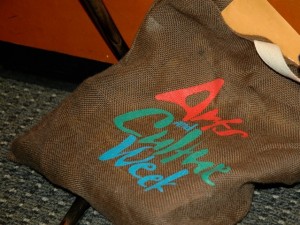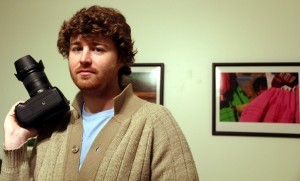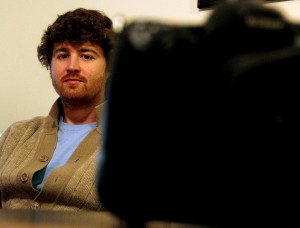Environmental film night promotes living chemical-free
February 15, 2011 by Miranda Gathercole · 2 Comments

Sisters Doreen Dewell and Joyce Rostron form the Green Ideas Network, a non-profit organization aimed at creating healthier communities. They, along with Gary Jones, are the main organizers for Green Wednesdays. (Photo by Lucas Meneses-Skoda)
Saving the environment could be as easy as cleaning out the cupboard under the kitchen sink.
According to the Canadian documentary “Chemerical,” North Americans are poisoning themselves every day through the use of toxic chemicals in their households.
The documentary was shown last week as part of the monthly series, Green Wednesdays, held at the Kwantlen Langley campus on the second second Wednesday of every month. It follows the story of a family attempting to live chemical-free for 90 days.
The environmentally themed evening, hosted by Kwantlen’s School of Horticulture and the Green Ideas Network, is designed to show solution-based films to students and the general public about current environmental issues.
“The whole point of the Green Wednesdays is to give people some exposure to some of the kinds of issues around sustainability and the environment and our personal footprints on the planet, on whatever topic it happens to be,” said Gary Jones, horticulture instructor and event organizer.
In the documentary, there are many funny and emotional moments as the Goode family quickly realizes how dependent they are on chemicals in their home. According to the film, the average household has more than 40 toxic items that contain dozens of harmful chemicals known to contribute to health problems, including sterilization and cancer. The film suggests that this is directly related to studies showing that women who stay at home have a risk of cancer 43 per cent higher than those who work outside the home.
Products such as laundry detergent, window cleaner and even deodorant and cosmetics expose people to chemicals including trichlosan (a known carcinogen used in antibacterial products,) chlorine ( the number one toxic chemical in the home, used in bleach) and ammonia (used in cleaners) on a daily basis.
“I always try and buy green products, and it’s surprising just knowing that everyday products are pretty dangerous,” said Rachel Sproule, a first-time attendee to Green Wednesdays. “How are all of these products allowed on the market without any sort of warnings?”
Andrew Nisker, director of “Chemerical,” explores loopholes in the regulation system of the cleaner and cosmetic industries. Companies avoid labelling many ingredients in their products to protect “trade secrets.” Nisker reported on a study of 33 different brands of red lipstick that found 61 per cent of them to contain lead.
“If you can’t eat it, then you shouldn’t be putting it on your skin,” said an owner of a natural product company also showcased in the film.
Jones says that the point of showing these films is not to depress people, but to educate them and motivate them to make changes.
“It’s not just come here, listen to a movie about how there is going to be no oil here in 10 years time, go home and slash your wrists kind of deal. I like people to go home inspired enough to go find out about the subject and make their own informed decisions on what they are looking in to.”
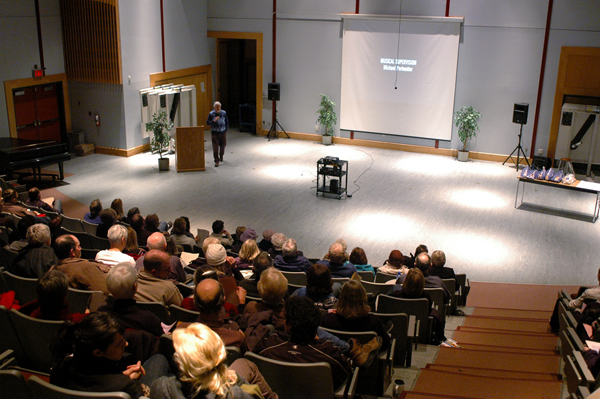
The fifth installment this year of Green Wednesdays was held in the auditorium on the Langley campus. The night was presented by Kwantlen's School of Horticulture and the Green Ideas Network, who work together to put on the eco-friendly movie nights once a month. (Photo by Lucas Meneses-Skoda).
Nichole Marples, executive director of the Langley Environmental Partners Society (LEPS) says “It all comes down to awareness. People saying, ‘Oh gee, I never thought of that before.’ I think these Green Wednesdays are awesome because they open the conversation, get people thinking about, ‘Oh gee, maybe that’s not the greatest thing’ or, ‘Oh, I’ve been using this for years and I didn’t actually understand it.’”
Jones says it is important that people begin to pay attention to the effects they are having on the earth and to make conscious decisions to change their habits.
“It’s life and death. How more important could it be? There’s some scary stuff out there, and we don’t know half of it. We have no idea. That’s what’s really scary, that we think we’re in control, but we have no clue really,” he said.
Joyce Rostron, vice-president of the Green Ideas Network, shares the same ideals.
“I do this for my children. They will really look to the future with open eyes. They won’t be so closed-minded about things,” she said.
Jones adds, “People come [to Green Wednesdays] for all sorts of reasons. My hope is that they go away a little bit more educated about some of these things. They’re not going to know everything about the topic, but if they can go away and get really interested they might go and do their own bit of research. Who knows?”
Funny girl, and a busy girl, too
February 15, 2011 by Jocelyn Gollner · Leave a Comment
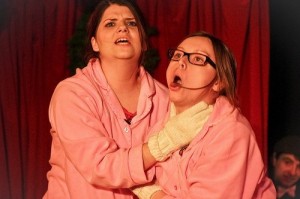
Nicole Passmore (left) and Kaitlin Fontana perform in their sketch group, Pony Hunters. (Photo courtesy of Kaitlin Fontana)
Kaitlin Fontana is a writer, sketch comedian, improv comedian and all-around funny girl.
And, after been involved with the comedy scene for roughly 10 years, she knows what she’s doing.
Fontana started out being involved in high school performances, and later was involved with UBC Improv. That lead her to doing comedy and improv with groups in both Vancouver and New York.
“I feel everyone needs something that allows them to explore their imagination and that creative part of themselves,” Fontana said. “I feel like comedy is that for me, particularly improvisation.”
She’s even started her own all female improv group, called Rosa Parks Improv.
“It started because I was surrounded by all of these awesome female improvisers and I wanted to take and perform on our own somewhere, just for kind of a different vibe. When all women are doing something, it changes things,” Fontana said.
Fontana has also formed a sketch group called Pony Hunters with one of the members of Rosa Parks Improv, Nicole Passmore, called Pony Hunters. A lot of their comedy is Star Trek-related, as how both Fontana and Passmore are big fans.
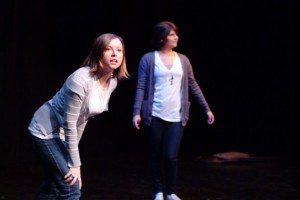
“I guess I would describe [my sense of humour] as nerdy and intelligent with a healthy dose of the ridiculous,” Fontana said. “I’m a nerd who reads a lot, so that comes out in my improv, for sure.”
Although Fontana is involved with many different forms of comedy, improv is where her heart is.
“The feeling of doing a really good improv show is very satisfying because, while I enjoy scripted work, and when it goes well I’m very happy with it, there’s a sense that it was programmed to succeed,” Fontana said. “Improvisation is much more risky. You don’t know what’s going to happen on stage. It’s not just you. It depends on the entire group of people you are performing with. It depends on trust and the energy in the room. And that undefinable other thing that makes comedy good, or makes any art good, that we can never really put our finger on. It’s like that magical ingredient.”
Fontana is busy with several comedy and improv shows coming up. Pony Hunters will be featured at an upcoming art exhibition about comedy at the Helen Pitt Gallery, where they will be showing the first episode of one of their web series, called Shitty Spock.
“It’s about a shitty version of Spock coming to Earth and trying to rescue his captain, and has found that his captain has become a mid-20s female, who lives on Earth and doesn’t realize that she is the captain. So basically it’s an odd couple comedy,” Fontana said.
She’s also performing on Feb. 17 at The China Cloud in Chinatown with Ghost Jail Theatre, an improv and spontaneous writing group.
Then, from Feb. 23-26, she’ll be performing at the CBC Studio 700, with a bunch of other improv groups from around the city.
“Someone once said that it takes 10 years to be good at anything. I feel like I’m starting to get to that point where I feel very comfortable in [improv] and I like to explore it, teach it and direct, as well as perform. And it’s like anything. I mean why does a painter paint? The motivation is that creative impulse.”
KSA providing Jitterbeans despite high levels of caffeine
February 14, 2011 by Josh Saggau · 1 Comment
Life as a student can be exhausting; homework and studying are enough to keep even the best students up all hours of the night.
But the KSA has your back. They’ve got Jitterbeans. The chocolate-coated espresso beans are now available, by the handful for just a dollar, in vending machines on campus.
Jitterbeans, made by Osmanium Candy Company, are usually sold in either 40 gram or 17 gram boxes but the KSA wants to make sure Jitterbeans are popular at Kwantlen before selling them on a large scale.
“Right now, it’s just the vending machines but if people like them and everything is okay we might look at other areas,” said KSA marketing coordinator Nathan Griffiths.
There could be a problem with large-scale selling of the beans though. Each 40 gram box of Jitterbeans contains roughly 600 mg of caffeine.
“That’s a lot of caffeine. Normally we wouldn’t stock a product like this for that reason but Jitterbeans has been so open and honest about the sheer quantity of caffeine that we thought that students were well informed… and could make the best decisions for themselves,” said Griffiths.
The Jitterbeans posters hanging on bulletin boards throughout the campus say the 600 mg of caffeine per box is equal to six cups of coffee or seven and a half cans of Redbull. They also have a disclaimer at the bottom warning students against eating more than one box per day.
Registered dietitian Natalie Brown echoed the Jitterbeans warning saying that even one box is probably too much. She said Health Canada recommends no more than 400 mg of caffeine per day and that it should be spread out over the course of the day.
“When we have a lot of caffeine at once, it can cause a lot of different things. The acute symptoms are it can cause nausea, vomiting, heart complications, gastro-intestinal upset and then, as well, when you consume a huge amount like that, 600 mg, all at one time, it’s really hard on your system. You could potentially cause yourself to have a heart arrhythmia. [People] actually could have heart attacks from having too much caffeine at one time so it’s very dangerous,” said Brown.
She also said that mixing Jitterbeans with alcohol would be even more dangerous. The high level of caffeine would make a person feel less drunk. She said that could lead to excessive drinking, and possible alcohol poisoning, or someone getting behind the wheel of a vehicle without realizing they are intoxicated.
“The alcohol in your blood is still the same but you’re not feeling the effects of it because of the caffeine keeping you stimulated. It’s a very dangerous combination to be dealing with.”

A comparison of the amount of caffeine found in Jitterbeans to other high-caffeine products. (Infographic by Hayley Woodin.)
Twenty-Something Theatre: Giving young talent a chance
February 14, 2011 by Meagan Gill · Leave a Comment
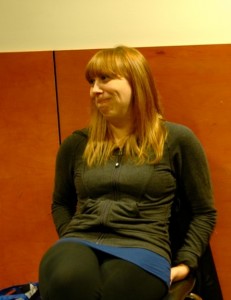
Sabrina Evertt, founder and artistic producer of Twenty-Something Theatre. (Photo by Jocelyn Gollner.)
Twenty-Something Theatre can be described as edgy, cool, provocative and definitely not your grandma’s theatre. At least, that’s what Sabrina Evertt says.
Evertt is the founder and artistic producer of the independent theatre company Twenty-Something Theatre. She describes the content and dialogue of their productions as realistic.
“It’s the kind of thing you would see or speak on the street. People see themselves in that and they can relate to it,” she says.
Productions are generally geared to 18- to 35-year-olds, with scripts that speak to the younger generation. “The transition from being a young adult in school, to real life, finding a job, finding purpose and finding love; all of those kind of things, like finding out who you are and what you want to do, are what a lot of our plays are about,” says Evertt.
Her passion for theatre started when she was around 16. All of her friends were in the drama club, so she decided to try it out. She was cast in one of the productions and she was hooked. “I think a lot of people who do theatre have a need to do it. I think you just kind of get hooked and it’s in you and you have to do it,” she says.
After high school, Evertt attended UVic and got a BFA in theatre. She says one of her biggest influences were her high school drama and improv teachers and college professors. “They helped me keep going and shaped what I wanted to do. They all just really encouraged me,” she says.
Evertt has many productions on her resumé, including both producing and directing Blue Surge, The Fever, Anne Frank Is In My Dreams, Suburbia, The Shape of Things and others. Not only is she a producer and a director, but she is also a costume designer. “I guess I’ve always had a flair for fashion and clothing”, she says. She has done the costume design for productions that include Werewolves, Hamlet, As You Like It, Banana Boys and Stuff Happens.
Currently, she is producing and directing the play Nocturne, written by Adam Rapp and featuring Troy Anthony Young. Nocturne is a one-man play, around 80 pages long, and Young has quite the challenge. It’s about a man’s journey to find closure and redemption after causing an accident that tore his family apart.
[audio:Nocturne.mp3]
Young started acting when his mother enrolled him in drama classes almost against his will. Soon, he realized he enjoyed it. “You know how most people spend time in their lives just trying to find that one thing that makes them feel right about themselves? That’s what is was for me,” says Young.
Young always hoped that one day Evertt would find a play that he could have a part in, but he didn’t expect it would be in this one and, after four years of waiting, he finally got the chance to work with her. Despite the challenges, he says it’s rewarding.
“The things I’ve seen Sabrina direct before has always been really really challenging theatre. Things you don’t see a lot of in this city. She doesn’t hire the actors you see on stage everywhere else, she gives a break to some people and gets some of the most amazing performances on stage I’ve ever seen,” said Young.
Young describes Evertt as supportive and one of the hardest working people he knows. “She could have moved to New York City and by now probably have an off-Broadway company running in the amount of time that she’s been running Twenty-Something Theatre. And she’s chosen to stay here in Vancouver, and give us a chance to get on stage and promote the people here and I think that’s one of the most honourable things in the world,” he says.
Evertt started Twenty-Something Theatre to give young actors and designers the opportunity to have careers in theatre. “I would also love to be able to financially support young people as well, as opposed to just giving them a opportunities to gain exposure,” she says.
As an independent theatre company, there are challenges.
One of the major issues facing independent theatre companies is being able to find the funding to put on the production. As a producer, that’s what Evertt spends most of her time doing. “It’s also difficult to get audiences out to see your shows, especially when your competing in this culture with TV and movies and computers and music. There’s so many options for young people,” she says.
Evertt describes Vancouver’s theatre scene as small in comparison to other places, so therefore, it’s relatively young. She mentions the big three: the Arts Club, the Playhouse and the Bard on the Beach festival. Other then that, she says, you’ve got the independent theatre companies who have been around for awhile, such as Pi Theatre, Neworld Theatre and the Electric Company Theatre.
Evertt says she would like to see Vancouver’s theatre scene take bigger risks in the material they produce. “I think that you take certain risks by incorporating technology, and that’s very interesting and that’s very different but it’s more focused on innovation and that kind of thing,” Evertt says. “I would like to see people return to telling stories, but then taking risks with those stories, like pushing boundaries and discussing topics that are relevant to today,” she says.
To learn more about Twenty-Something Theatre, visit the theatre company’s website.
Swapping the office for a more colourful picture
February 13, 2011 by Amanda Punshon · 2 Comments

Mark Feenstra quit his office job to pursue a career in fashion photography. (Photo by Sarah Casimong)
At first blush, it seems like something out of a Hollywood movie. Just over a year ago, Mark Feenstra quit his day job as an inventory analyst for Mountain Equipment Co-op in Vancouver to pursue more creative endeavours. If it were a movie, his decision would have been a spur-of-the-moment, dramatic impulse that caused his doting girlfriend no end of financial and emotional distress.
“It really wasn’t a last-minute decision or impulsive thing. There was definitely some soul-searching that went into that,” said Sarah Pawliuk, Feenstra’s girlfriend of two years. “I wasn’t freaked out that it was going to be a big disaster because he’s a really responsible and almost overly-thinking person.”
Feenstra described his position at MEC was a “stepping-stone job,” the kind of job people take when they’re looking to move up in the company.
“One day, I realized that I didn’t want to be where I was going next,” he said. “I loved everything about the company except what I was actually doing when I was sitting at my desk.” So he started making plans to leave the company. He saved money for over two years before he actually quit.
“I knew I needed to make a change while I was still young enough to do that easily. You can do it an any age, but I don’t have kids, I don’t have a mortgage. Now is a pretty good time to take on a high-risk endeavour.”
Feenstra said that he initially took time off to work on his writing. He went to Costa Rica for three months to surf and get himself into a “more creative headspace.”
When he came home, he realized that fiction writing wasn’t going to pay the bills. Even if he wrote the next great Canadian novel, found an agent and a publisher, it would still be at least two years before he earned any money.
“Rather than go back to work this year, like I had originally planned, I’ve decided to use that incredible, gripping fear of having to go back to an office to kind of push me into photography and trying to make a living at it,” he said.
Photography had been a passion of Feenstra’s for as long as he could remember. It was a hobby he shared with his mother, a cancer researcher-turned-biology teacher. He still has the nearly 30-year-old Nikon SLR camera he grew up using.
Feenstra is science-minded – another thing he inherited from his mother – and mechanics of operating a camera really appealed to him. “It’s kind of a way for me to approach more artistic endeavours but still have an element of control,” he said.
Another thing that appealed was the way photography forced Feenstra to step outside himself.
“I hate public speaking, I hate having to show up and meet strangers. Even just going to a party where I don’t know that many people, I get weird anxiety before I have to go. Yet I really want to shoot people. I like portraits, I want to do fashion photography, these are the things I want to do. And I’ve lately just been throwing myself into these scenarios where I don’t know anybody,” he said. “It always turns out to be these amazing experiences.”
Shyness isn’t the only thing Feenstra struggles with.
“One thing that still hasn’t gone away with writing or photography is just huge creative fear barriers. That kind of feeling that you’re not good enough, that you shouldn’t be doing this, that you don’t deserve it,” he said. “At the end of the day, the biggest challenge is just getting over my own inhibitions and just kind of feeling like I shouldn’t be doing this and doing it anyways. And getting through that every time has probably been the biggest challenge. Everything else, when it actually happens, is easy.”
But he sees the challenges as being an important part of the creative process.
“If you’re not a little bit scared of not pulling something off, then you have to question how worth doing it is,” Feenstra said. “If you’re trying to be creative and you’re trying to do something interesting or something that other people can interact with, then you have to be going out into at least your own unknown a little bit. Because if it’s just too easy, then why should anybody else be interested?”
Feenstra wants to break into fashion photography, in part because there are some fairly lucrative career opportunities in the industry, but also because it allows photographers to be creative.
“You flip through magazines, some of the stuff is just garish and awful, and you don’t know how anybody would publish something just so hideous and weird. But it’s great that that’s what somebody got to do,” he said.
He hopes to have his own studio one day, but his dreams are both bigger, and smaller, than that.
“I’d love to be ‘that guy’ in Vancouver where, when celebrities come through town, it’s like, ‘Oh, can we get Mark Feenstra to come in and shoot for the day?’ And I think it’s important to always keep that in mind and believe — act — as though that’s where you’re headed. I think it’s really important to pick a completely and seemingly unobtainable goal, and everything you do should build a foundation to get you in that direction,” he said.
Feenstra said he sees himself as being on the road to his dream, but he’s not hung up on achieving it as soon as possible.
“There’s a certain level of general fashion photography and editorial work that I’d be very happy with for a very long time. I don’t have to get up there, but that’s the general direction. And still, the really important thing for me to do is not get lost in that, and doing everything just commercial work.
“[I want] to pursue some of those personal creative projects without monetizing them,” Feenstra said. “If I want to take a couple months off to go shoot tribes in Borneo without trying to make a lot of money and be worrying who to sell that to, that would be a great place to be.”
Feenstra is not one of those people that’s putting himself all over the Internet in hopes of making a little money. But he is confident that he will eventually turn his passion into a lucrative career.
“If you have a good product, people will find you,” he says.
If you’d like to see samples of Feenstra’s work, you can visit his profile site at www.markfeenstra.com.
Eagles vs. Kermodes: In pictures and sound
February 12, 2011 by Jeffrey Yip · Leave a Comment
After an unfortunate road trip to Prince George, the Kwantlen Eagles’ men’s team returned home to face Quest University’s Kermodes on Friday, Feb. 4, a team they’d never lost to at home. Coming into the game the Eagles had lost seven straight, bringing their record to 1-11 for the season.
That controversial referendum
February 7, 2011 by Brittany Tiplady · 2 Comments
Chronicle reporters Stu Gallacher and Brittany Tiplady team up for a satirical look at last week’s multipass referendum on Kwantlen’s Richmond campus. Election results are expected this week.
Eagles’ basketball coach cites personal reasons, resigns
February 7, 2011 by Hayley Woodin · 1 Comment

Coach Bernie Love gives him team a pep-talk right before their Feb. 4 game against the Quest Kermodes. (Photo by Josh Saggau)
The 2010-’11 basketball season will be the last for Bernie Love, the head coach of Kwantlen’s men’s team, who announced his resignation last week.
Love, who has coached the team for nine of the past 12 years, said his reasons for leaving were personal, and had nothing to do with the team’s poor record: He is moving to Trail to be closer to family.
“It wasn’t an easy decision. If I was not moving back there, then I would be back,” he said, explaining he had made up his mind several weeks ago.

Coach Bernie Love screams at his team during their Friday night game after the Kermodes came back to erase a huge lead. (Photo by Josh Saggau)
When Love broke the news to his team, he was met with an “expressionless” response.
“They’re a bit of a quieter group. Not a lot of them said anything,” he said. “Maybe when the season’s done, then the goodbyes will come.
“I think that the last Saturday night will probably be a little bit tough.”
According to guard Doug Meyers, the silent reaction on the team’s part may have been for less-obvious reasons.
“There’s definitely a player-coach tension. It may not show, it may not come out in front of the team, but guys talk: It’s just the nature of the game,” said the second-year student.
“The problem here that I have most with Bernie is there’s a lack of accountability and perceived caring on his part and it leads to the team.
“Things that come from the coach definitely effect what goes on on the floor. I’m not going to say that it’s 100 per cent the coach, that it’s 100 per cent the players, it’s definitely a combination.”
The Eagles have suffered through nothing but losses since late November, a combination of poor shots and missing links on the players’ part; a lack of accountability and cancelled practices on the coach’s, according to Meyers.
He said that while the Love gave him “a lot of confidence” to be able to grow as a player and reach his potential, he didn’t follow through with his high expectations for the team.
“Talk the talk, walk the walk. In my opinion, Bernie’s a talker. It sucks to say, I haven’t seen a lot of walking,” he said.
On a personal level, Meyers went through what the team as a whole is struggling with.
When he was in Grade 9, he knew he loved the game; he also recognized that he “sucked.” But he confronted his coach with the goal in mind to be the team’s star by Grade 12. He was playing on the provincial team by the end of high school.
“I understand what it takes to get to that level [and] I just haven’t seen it here,” Meyers said.
Despite the effects of the coach’s “negative undertones” on the team, according to Meyers, Love is able to acknowledge part of the tension and focus on the positive.
“There’s wins and there’s losses,” Love said. “Obviously we’d like to be doing a lot better than we are… I don’t call this a waste of a year at all.”

Love is moving on from coaching university level teams, but not necessarily from coaching in general: He may coach at the high school and junior high level in the Interior. (Photo by Josh Saggau)
Year of the rabbit emotional time for Chinese student group leader
February 7, 2011 by Lucas Meneses-Skoda · Leave a Comment

Elaine Wang wears the colour red, a symbol of luck, for her mother who was born in year of the rabbit. Photo by Miranda Gathercole.
For one Kwantlen student, welcoming the Year of the Rabbit was emotional in a different way than usual.
Elaine Wang, president of the Chinese Student Association, celebrated the most important Chinese festival away from her family for the first time in her life.
“It makes me want to cry,” she said. “I got up earlier and [Skyped] with my family and we count down together.”
Wang immigrated to Canada less than a year and a half ago to study at Kwantlen, while living with her uncle in Richmond.
For Wang, this Chinese New Year spent away from family in China marked an opportunity to work with the KSA and open up Chinese culture to the students of Kwantlen. Wang says that it is also a way to bring a sense of community to other Chinese students who might be missing family back in China.
“Kwantlen is just like a home for us… Kwantlen is big family for us. So, we want the students to feel less lonely,” she said. “They are not alone, they are with us… we are all family members in continent.”
The group set up tables and handed out pork buns and sweet treats, traditional Chinese delicacies which are often eaten in the celebration of the New Year, to students at the Richmond, Surrey and Langley campuses on Feb. 3.
“We tried to choose items that would respect the traditional Chinese New Year aspect of it and something that all students could eat and try,” said Reena Bali, director of events and student life for the KSA.
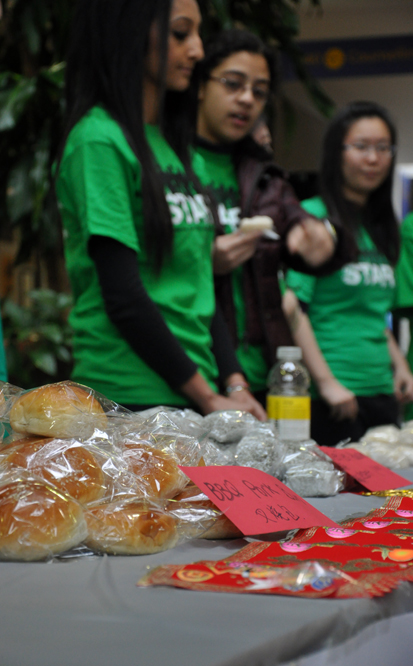
Lesha Ghirra, left, and Sarah El Bakkouri volunteer with the KSA to hand out BBQ pork buns, green tea-flavoured desserts and peanut-flavoured desserts to Kwantlen students at the Richmond campus. Photo by Miranda Gathercole.
Although Wang is happy to spend the celebration of the Year of the Rabbit in Vancouver with her friends and her uncle, it is difficult for her to be without her parents at a time that is “just like Christmas in Canada.”
“Yesterday, I even worked last night. I work at a restaurant and I see a lot of families who are immigrants. They get together and they celebrated… and the parents gave children red envelopes. I felt so sad because I was all alone here.”
In China, red envelopes, which usually contain money, are given by elders to children and family members to represent good fortune to come in the New Year.
“My grandfather said ‘I will keep the red envelope for you. If you go back China, I will give you,’ so it make me very happy,” she said.

Nicole Joe, Richmond representative for the KSA, hands out tradition Chinese treats in the rotunda at the Richmond campus on Feb. 3. Photo by Miranda Gathercole.
Getting started in film cheap, easy, says local filmmaker
February 6, 2011 by Amanda Punshon · 5 Comments
Quentin Tarantino taught himself the history of film. Sir Ridley Scott worked on roughly 2,700 commercials before he made it big with Alien. Robert Rodriguez sold his body to science to fund his filmmaking.
These guys are incredibly passionate about film. It’s easy for them to make movies because they have lots of money. But they didn’t always, and if you want to make your own films, you don’t need to be rich either.
Rob Hunt is a local independent filmmaker. Like Tarantino, he didn’t go to film school. He says he would have if he’d had the money, but film programs are really expensive.
“I think that the problem with a film program is that you go and you spend all this money, and you don’t walk away with any equipment. So you really have to be aware of that. If you’re going to be in a film program, you have to be there 110%. You’ve got to be using the equipment, you’ve got to be making friends and contacts,” Hunt says.
And, of course, there’s no guarantee that you’ll get a job once you graduate.
Hunt, who has a degree in computer science from the University of Victoria, has filmed two feature films and purchased all of his own equipment in approximately the same time as a film program would take.
He’s currently directing Standard Action, the Dungeons & Dragons-themed webseries he co-created with girlfriend Joanna Gaskell.
Hunt isn’t afraid of a little competition. In fact, he welcomes it.
“I wanna see cool stuff, and I don’t like what the big studios are doing,” he says. “You’ll see ideas come from independent film that studios are not willing to take a risk on.”
EQUIPMENT
If you want to make your own film, Hunt says you only need a few simple things.
The first is a digital single-lens reflex camera that shoots HD video. Hunt shoots Standard Action on a Canon T2i, which costs around $800. The 7D is also a good option, Hunt says, but it’s a lot more expensive.
Buying a cheaper camera means less of a financial loss if the camera is broken or confiscated. It also means you can buy a second camera, which saves time because it allows you to shoot a scene from two angles at the same time.
Hunt quotes Stu Maschwitz, the man behind filmmaking blog Prolost, as recommending the T2i over the 7D because it has recently been hacked, which has unlocked (for free) a lot of features that would ordinarily come on cameras that cost thousands of dollars more. The hack is pretty recent, so he advises waiting a few months before using it on your camera to make sure it’s stable.
If you buy your camera in a kit it will come with a couple of lenses, but Hunt advises upgrading them. He says a fast 50mm lens, which costs around $100, will work well in low-light situations. It’s also a good idea to get a wide-angle lens, he says, and a “reasonable” tripod.
DSLR cameras shoot beautiful video but the audio quality isn’t very good, so you’ll have to buy an external recording device of some kind. Hunt uses the Zoom H4n (around $350) on Standard Action, but he says he’s seen sound guys using even simpler devices with good results.
Hunt says that, in addition to the recorder, you’ll need a microphone. “You need a basic boom mic and boom pole. A boom pole is like 50 bucks, and boom mic or shotgun microphone, those are like 200 dollars.”
And since you’ll be recording your audio and video separately, you’ll need a slate (also known as a clapboard) which is basically a piece of plastic or wood with two pieces that click when they’re brought together. It makes adding the separate audio track to the video easy during the editing process – you just line both up at the click.
“That’s kind of old school and it’s come back again as a real requirement,” Hunt says.
If you’d like to dabble a bit in lighting, Hunt recommends starting with a good bounce (also known as a reflector) to hold under actors’ faces for close-ups. “It just makes the face a little bit lighter, and more professionally-lit looking,” Hunt says.
A basic lighting kit can come in handy, too. They have just three small 300-watt lights, but DSLR cameras are so good in low-light that that’s all you need. Hunt just bought one for around $300. He’ll be using it during the production of Standard Action episode four.
There’s also a nifty little camera-mounted LED light that’s great for making actors’ faces pop when shooting close-ups. According to Hunt, it’s handy for filming in forests because it maintains the dark, spooky atmosphere, but lights the actors very well. And in daylight situations, it provides more control over the quality of the light. Hunt says he found his for around $40 on eBay.
PEOPLE
“If you want to make film, you need a friend who is gullible enough to come out, hold the boom mic, and learn how to use whatever thing you’ve got to record sound,” Hunt says.
“You need a guy who knows how to make sure that he knows that he’s recording and not just listening to the sound, cuz there is that big difference. And to be able to not shake the boom mic around, cuz that’s important.”
Another handy person to have around is a set decorator. Hunt says that the addition of a set decorator has made Standard Action look that much more professional. And if you hire someone who can also do other things, like design costumes or operate your second camera, it will make your life that much easier and save you a lot of time.
WEBSITES
Hunt found his set decorator on Craigslist. “I’ve seen some great miracles happen from the people I’ve pulled off of Craigslist. I’ve had some incredibly talented and enthusiastic people,” he says.
“Don’t be afraid to try to find other people, just be ready to have a little bit of friction or find people who don’t actually help.”
Hunt advises posting the “gigs” section, because you have a better chance of finding people who share your passion for filmmaking and will volunteer their time to help you out.
If you need to fundraise, Hunt says IndieGoGo is the way to go. Creators set up pages on the fan-funding site and then anyone, anywhere can donate as much money as they like to the project. Hunt says it allows filmmakers to approach people they normally wouldn’t for funding, and thanks to IndieGoGo, he is now looking at being able to afford a premiere for his movie, The Director’s Project.
“That website alone has changed the whole game in the last year, and i really look forward to how that’s going to expand. I think that’s just going to get a lot better for us,” Hunt says.
And for those interested in special effects, Hunt says Video Copilot is a great site to visit. It’s run by Andrew Kramer, who created the title sequences for Fringe and the Star Trek movie. The site offers free tutorials in Adobe After Effects, which allows filmmakers to “make someone’s leg or head blow off” without any danger.
BOOKS
Hunt speaks very highly of the DV Rebel’s Guide: An All-Digital Approach to Making Killer Action Movies on the Cheap. He says “it’s like 80 bucks, but it’s like the Bible, or like a textbook. It’s not necessarily a storybook, but it’s everything you could need.”
He also highly recommends Robert Rodriguez’s memoir Rebel Without a Crew. “It’s the kind of book you read if you’re feeling down and you don’t want to make film any more. You read it, and then you want to do it again. ‘Cause, like, he sold his body to science to do it, and lived in an institution…it’s pretty epic.”
Hunt reads a lot. “Buy books on amazon and read them,” he says. “That’s how you really become a good filmmaker.”
OTHER MATERIALS
DVD commentaries are also a great source of information. Again, Hunt recommends Robert Rodriguez’s movies, because his commentaries and extras are geared toward filmmakers.
And the Lord of the Rings, with its 12 hours of commentary, “is such a huge wealth of stuff.” In addition to directors and actors, there are commentaries by the set designers, costume-makers and art designers. Hunt says that the ideas in commentaries are a good way to learn about what does and doesn’t show up on-camera so that you can pull off professional-looking special effects and costumes without having to spend a lot of money.
Hunt also recommends the DVD boxed set of The Middleman. The show, which ran for a single season in 2008, was based on a comic book about a girl recruited by a guy who fixes weird problems for a living to be his replacement.
COURSES
Kwantlen doesn’t offer any filmmaking classes, but Hunt says there are still some useful courses in the calendar.
The first, and most basic, is an introductory English course. Hunt says he once read a screenwriting book that advised writers to use the same essay-writing techniques he learned at university.
“Writing scripts for me…is very similar to writing a ten-page essay,” he says. “I’ll make notecards and I’ll lay them out on the ground, and it’s exactly the same as how i used to write long essays.”
Hunt doesn’t personally have a problem generating story ideas or writing fiction, but he says that if it’s a skill you need to work on, creative writing classes are a must. Kwantlen offers several that might interest filmmakers, including Introduction to Creative Writing I and II (CRWR 1100 and 1110), Drama, Fiction and Poetry I and II (CRWR 2300 and 2310) and Screenwriting I and II (CRWR 3120 and 3220.)
Jason Lieblang, who teaches German Culture through Film (CUST 3300,) thinks that his course would be beneficial for aspiring filmmakers too.
“You definitely don’t learn the practical skills necessary to make films in a class like mine, that is, editing and how to work a camera and those types of things,” Leiblang says. “You do learn about the history of cinema, about the great directors, about great sort of shifts in filmmaking that were crucial and important and affected the way that films were made after that.”
He also teaches students how to analyze films as texts, looking narrative and form so that students can understand film in a “a deeper, more profound way.”
On top of that, he teaches his students how to “communicate clearly, effectively and persuasively” by writing short argumentative essays.
And rather that writing a final paper, Leiblang says that students can do other kinds of projects, including making a film, if they can prove that they will satisfy the requirements of the assignment.
Kwantlen’s course calendar promises that Introduction to Film Studies (ARTH 1130) will teach students about the “history and development of world cinema” and about “film as a visual language and art-making practice,” and says that students “will learn methods for exploring aesthetic function and for considering the social, political, and technological contexts” of movies. This, like Lieblang’s German Culture Through Film class, will teach you some basic film terms and give you a good grounding in the interpretation of film.
If you’re interested in understanding film and having a lot of control over the way your films are interpreted, Eryne Donahue’s Introduction to Visual Culture (FINA 1167) course may be for you. Donahue says that her class will help students understand films from a variety of perspectives.
“[Filmmakers] could sort of get a sense of how that stuff is put together and then how it’s read by the public,” she says. “They could from there get a sense of what’s already out there and how they could maybe contribute to it.”
Donahue also teaches Photography I (FINA 1170) which is the closest thing Kwantlen offers to a filmmaking class. She says it would be very beneficial for anyone who wants to make movies because a lot of the the language and principles involved are the same.
“It gives a pretty good understanding of how film works. They’re based on the same sort of principles, right, technically. And if they’re taking the course it also sort of slows them down because we’re dealing with film-based cameras instead of digital to start. They really have to kind of focus and put a lot of emphasis on the choices they make and that would set them up really well for storyboarding and planning for film,” she says.
She has some advice for students who want to get into film, too.
“The student should be prepared to do a lot of work,” Donahue says. “There’s no sort of standard path, really, with film or any of the arts, so you have to have a strong vision in mind to know really where you want to go with it.”
Links:
For more of the Chronicle’s coverage of independent arts in Vancouver, click here.
To watch Standard Action click here
Click here for Rob Hunt’s website.
Stu Maschwitz’s blog is here.
Video Copilot, which offers free special effects tutorials for filmmakers, is here.
Check Kwantlen’s course calendar for useful courses.
Amazon, Craigslist and IndieGoGo are useful sites for filmmakers.



